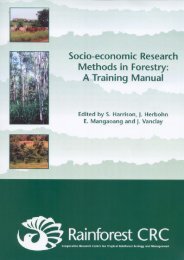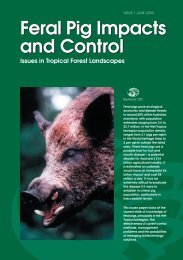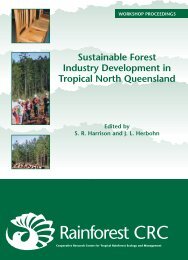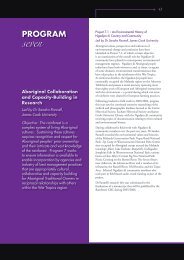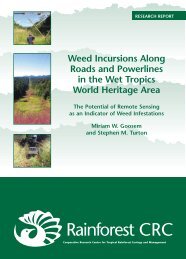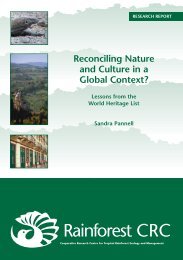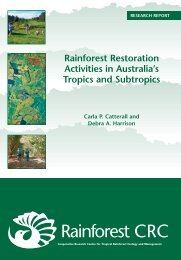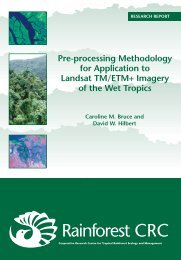Reconciling Nature and Culture in a Global Context? - Rainforest ...
Reconciling Nature and Culture in a Global Context? - Rainforest ...
Reconciling Nature and Culture in a Global Context? - Rainforest ...
Create successful ePaper yourself
Turn your PDF publications into a flip-book with our unique Google optimized e-Paper software.
<strong>Reconcil<strong>in</strong>g</strong> <strong>Nature</strong> <strong>and</strong> <strong>Culture</strong> <strong>in</strong> a <strong>Global</strong> <strong>Context</strong>?Lessons from the World Heritage Listanthropogenic l<strong>and</strong>scape is acknowledged by national governments <strong>and</strong> globalenvironmental organisation varies dramatically.P. J. Fowler gives us some idea of this variation <strong>in</strong> the UNESCO report on ‘World HeritageCultural L<strong>and</strong>scapes, 1992-2002’ (Fowler 2003). Of the 730 properties <strong>in</strong>scribed on theWorld Heritage List by 2002, only thirty are listed as ‘official’ cultural l<strong>and</strong>scapes (Fowler2003: 14). After exam<strong>in</strong><strong>in</strong>g the list<strong>in</strong>gs for ‘natural’, ‘cultural’ <strong>and</strong> ‘mixed’ properties, Fowlerfound that at least 70 other sites could readily be identified as cultural l<strong>and</strong>scapes accord<strong>in</strong>gto the World Heritage Convention (ibid: 60). While Fowler observes that the pre-1992 list<strong>in</strong>gof some World Heritage sites precluded their nom<strong>in</strong>ation as a ‘cultural l<strong>and</strong>scape’, he canonly surmise that the reasons why state parties have not seized upon “the new opportunitypresented by the creation of the category ‘cultural l<strong>and</strong>scape’ […] may well be economic <strong>and</strong>personnel [ones]” (ibid: 60). In solely focus<strong>in</strong>g upon f<strong>in</strong>ancial <strong>and</strong> logistical obstacles, Fowlerappears oblivious to the politicisation of nature, culture <strong>and</strong> heritage that surrounds the list<strong>in</strong>gprocess, lead<strong>in</strong>g one commentator to label World Heritage a “political football” (Sullivan2004: 51). As such, Fowler ignores the powerful discourses about an ‘untouched nature’ <strong>in</strong>which the idea of a cultural l<strong>and</strong>scape appears as an oxymoronic concept.As these comments suggest, the creation of a World Heritage area or a national parkimposes more than just new cadastral boundaries <strong>and</strong> regulatory regimes. The ‘eviction oflocal people’ that Igoe <strong>and</strong> countless others have commented upon is one of the moredisturb<strong>in</strong>g <strong>and</strong> long-last<strong>in</strong>g effects of the <strong>in</strong>tersection of a number of discourses focused upon‘the environment’. In this sense, the creation of a park also imposes scientific frameworksabout species <strong>and</strong> ecosystems, environmentalist notions about nature conservation <strong>and</strong>protection, elitists ideas about heritage <strong>and</strong> culture, developmental ideologies aboutcommunities <strong>and</strong> customs, bureaucratic concepts regard<strong>in</strong>g plann<strong>in</strong>g <strong>and</strong> management, <strong>and</strong>state-sanctioned assumptions about property <strong>and</strong> people’s rights. As Sullivan <strong>and</strong> otherspo<strong>in</strong>t out, <strong>in</strong> this situation rely<strong>in</strong>g upon “national or local government systems to encouragelocal <strong>in</strong>volvement <strong>and</strong> the foster<strong>in</strong>g of traditional practices is often unrealistic <strong>and</strong> counterproductive”(2004: 51). In the case of Komodo National Park, local <strong>in</strong>volvement at the behestof the Park’s authorities, the national government <strong>and</strong> the transnational environmentalorganisation The <strong>Nature</strong> Conservancy also proved to be an alienat<strong>in</strong>g <strong>and</strong> disempower<strong>in</strong>gexperience.As reported by the ‘Awareness Officer’ of the Indonesian NGO Yayasan Pusaka AlamNusantara 40 , established by The <strong>Nature</strong> Conservancy as part of its ‘environmental educationprogram’, the ‘globally good’ <strong>in</strong>tentions of the Park Authority have met with <strong>in</strong>difference fromthe local communities with<strong>in</strong> <strong>and</strong> adjo<strong>in</strong><strong>in</strong>g the Park (1996: 5). For local people “theprotected area is deemed an imposed regulation that puts constra<strong>in</strong>ts on their livelihood”(Bakar 1996: 28). Indeed, the officer concludes that:Dur<strong>in</strong>g the sixteen years s<strong>in</strong>ce the establishment of Komodo National Park ithas not yet been evident that the local communities play an active role <strong>in</strong>support of conservation efforts. The population <strong>in</strong> general rema<strong>in</strong>s <strong>in</strong>differentto the cause, <strong>and</strong> even presents a potential threat to the ecosystem” (loc. cit.).To combat this ‘<strong>in</strong>difference’ <strong>and</strong> ‘vitalise’ community participation, the Indonesianenvironmental NGO recommends, “the local community must be made to recognise that theyare to ga<strong>in</strong> greater benefits from the Park if they comply with conservation policies” (Bakar1996: 29). Notwithst<strong>and</strong><strong>in</strong>g the considerable f<strong>in</strong>ancial <strong>and</strong> logistical effort of the nationalgovernment <strong>and</strong> The <strong>Nature</strong> Conservancy to develop alternative livelihoods, “not <strong>in</strong> conflictwith conservation values” (loc. cit), it is clear that the local community regard these40 The ‘Nusantara Natural Heritage Organisation’.39




